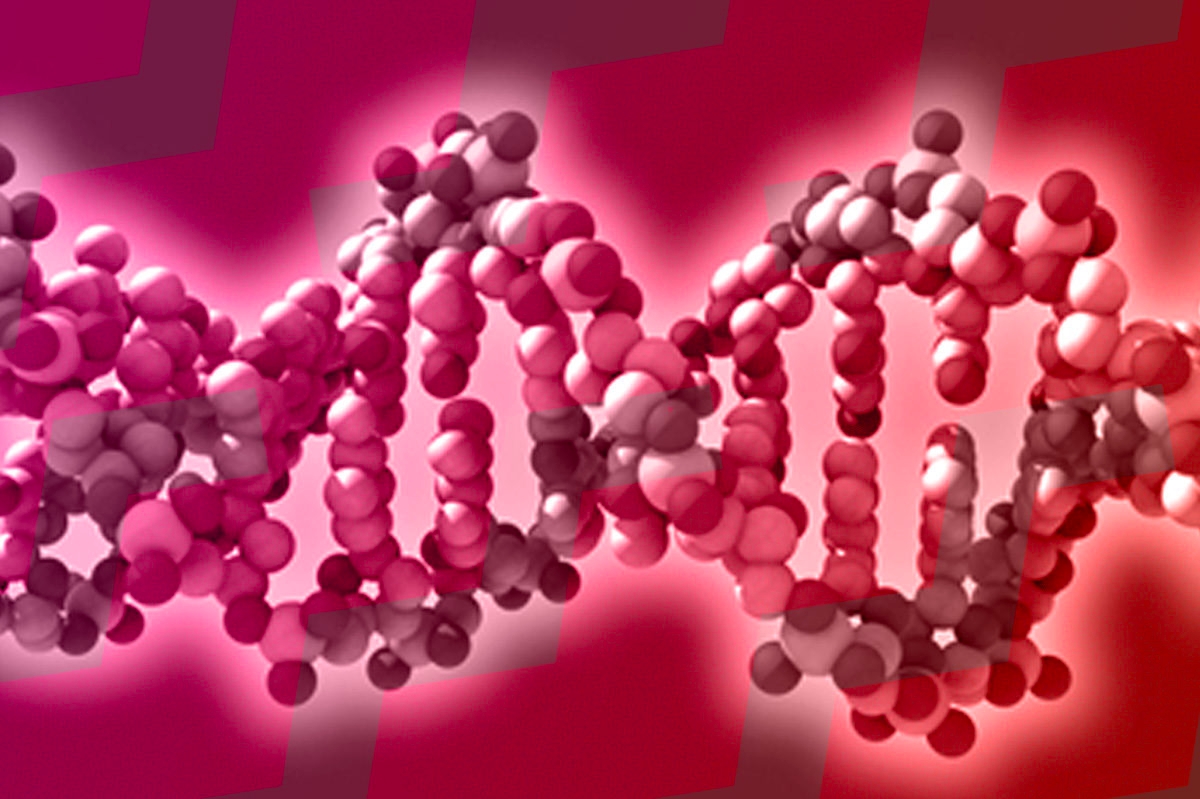Below are the 19 Ashkenazic Jewish genetic diseases for which people are most commonly screened. It is estimated that 1 in 5 Ashkenazic Jews is a carrier of a mutation in at least one of these disease genes:
Glycogen Storage Disease, Type 1a
Screening is also available for the following diseases on a more limited basis:
Dihyrolipoamide Dehydrogenase Deficiency (DLD Deficiency)
Bloom Syndrome
Individuals with Bloom Syndrome have short stature, sun-sensitive facial skin lesions, an increased susceptibility to infections and respiratory illness, and an increased predisposition to certain cancers and leukemia. Men with Bloom Syndrome are usually infertile, and fertility appears to be reduced in women. Some individuals with Bloom syndrome also have mental retardation. These individuals usually die at an early age, but some have survived until their 40s.
Bloom Syndrome is a rare disease that is most common in the Ashkenazic Jewish population. One in 100 Ashkenazic Jews is a carrier of this disease, which is caused by a change in a gene located on chromosome 15.
Bloom Syndrome is considered a “chromosome breakage” disease. This means that affected individuals have an increased rate of breakage and rearrangements along their chromosomes. Chromosomes are the structures in each of the cells in our body that contain our genes. Genes make up who we are and guide the development of the body.
Early diagnosis of this disease can be helpful in monitoring and treating the manifestations of Bloom Syndrome. Affected individuals should be more attentive in their surveillance for cancer and should also decrease exposure to sunlight and X-rays, which may cause damage to their chromosomes.
Return to the top of this page.
Canavan Disease
Canavan Disease is a severe degenerative disease of the central nervous system. Most children with Canavan Disease appear normal at birth. It is not until three to five months of age that their parents might notice subtle differences in the child. For instance, the child may be unable to perform motor tasks, such as rolling over. Grasping and visual inattentiveness or tremors are frequently noted. These children eventually become blind and have problems with swallowing. They frequently die in childhood but may live into adolescence or even early adulthood.
Canavan Disease is caused by the lack of a substance called aspartoacylase (ASPA). ASPA is an enzyme that breaks down another substance called N-acetylaspartic acid (NAA). The missing ASPA causes the NAA to build up, leading to brain damage, mental retardation, and the other problems seen in this disease.
Currently, there is no cure for Canavan Disease. There are some treatments available for managing and relieving the complications associated with Canavan Disease. These include physical and occupational therapy, a feeding tube when eating becomes difficult for the child, and certain medications for seizures and relief of pain. Research is presently being conducted to determine the safety and efficacy of gene therapy for this disorder. One in 40 Ashkenazic Jews is a carrier for this disease gene, located on chromosome #17.
Return to the top of this page.
Cystic Fibrosis
Cystic fibrosis (CF) is a disease that makes the body produce an abnormally thick, sticky mucus. This is what happens when cells in the lungs and pancreas fail to transport salt in the body where it needs to go. The thick mucus also blocks digestive enzymes from reaching the intestines where they are supposed to break down and digest food.
Individuals with CF have a variety of symptoms. The most common are: very salty-tasting skin; persistent coughing, wheezing or pneumonia; excessive appetite but poor weight gain; and bulky stools. The standard diagnostic test for cystic fibrosis measures the amount of salt in a person’s sweat. A high salt level indicates that a person has CF.
CF is one of the more common diseases and it affects approximately 30,000 children and adults in the United States. The carrier frequency amongst all Caucasians, including Ashkenazic Jews, is approximately 1 in 25. The gene for CF is located on chromosome #7.
CF is not yet curable, but in recent years, researchers have learned a great deal about the CF gene and have developed many new treatments. CF treatment depends on how advanced the disease is and what organs it affects. Chest physical therapy, antibiotics, inhalation treatments, and enriched diets are few of many treatment options.
Return to the top of this page.
Familial Dysautonomia
Familial Dysautonomia (FD), also known as Riley-Day Syndrome, is a disease that causes the autonomic and sensory nervous systems to malfunction. The autonomic nervous system controls bodily functions such as swallowing and digestion, regulation of blood pressure and body temperature and the body’s response to stress. The sensory nervous system helps the body to taste, recognize hot and cold and identify painful sensations. The disease is also known as HSAN III (hereditary sensory and autonomic neuropathy, type III).
The hallmark of FD is the lack of overflow tears with emotional crying. Children with FD may have difficulty feeding. They also may be unable to feel pain, and can break bones or burn themselves without realizing they’ve been injured.
The disease is caused by mutations in the IKBKAP gene, on chromosome #9. An estimated 1 in 30 Ashkenazic Jews carries the FD gene change.
Currently, there is no cure for FD. Treatments aim at controlling symptoms and avoiding complications. Treatment strategies can include using special feeding techniques and special therapies, medications, artificial tears, respiratory care and orthopaedic management.
Return to the top of this page.
Fanconi Anemia
Fanconi Anemia is an inherited disorder characterized by a reduced number of all types of blood cells in the body, leading to bone marrow failure. Individuals with Fanconi Anemia are usually smaller than average. Other symptoms associated with the disease may include missing bones in the thumbs and arms, increased risk for cancer and leukemia, brown coloring to the skin, and kidney problems. Ultimately, Fanconi Anemia affects all systems of the body. Patients rarely reach adulthood.
Fanconi Anemia is considered a “chromosome breakage” disease. This means that individuals affected with this disease have an increased rate of breakage and rearrangements along their chromosomes. Chromosomes are structures in each of the cells in our body that contain our genes. Genes make up who we are and help our body to function.
Approximately 1 in 89 Ashkenazic Jews is a carrier for this disease gene, which is located on chromosome #16.
Early diagnosis of this disease can lead to increased surveillance for leukemia and cancers. Therapy with steroids and bone marrow transplantation may be helpful for the reduced amount of blood cells in the body. Affected individuals should avoid X-rays, chemotherapeutic agents, and other environmental exposures that may cause damage to their chromosomes.
Return to the top of this page.
Gaucher Disease
There are three different types of Gaucher (pronounced go-shay) Disease (type I, II, III). Type I is the most common form of the disease. The signs and symptoms of Gaucher Disease vary greatly and can appear at any age. The most common symptom of type I Gaucher Disease is an enlargement of the spleen and/or liver, which is usually painless. There is no central nervous system involvement. Other symptoms may include bruising, bone pain, frequent nosebleeds, and a lack of energy. Also, children with type I Gaucher Disease may be shorter than their peers and may have delayed puberty.
People with Gaucher Disease lack an enzyme called glucocerebrosidase and are unable to break down a fatty substance in their cells. Therefore, this fatty substance builds up in the liver, spleen, bone marrow and other areas of the body. This buildup leads to the signs and symptoms seen in Gaucher Disease.
An estimated 1 in 14 Ashkenazic Jews is a carrier of a mutation in the Gaucher Disease gene, which is located on chromosome #1.
Although there is no cure for Gaucher Disease, there are some treatments available for managing and relieving the symptoms. Enzyme replacement therapy is an effective, yet time consuming, form of treatment. The treatment consists of a modified form of the glucocerebrosidase enzyme given intravenously. This therapy can lead to an improved quality of life for affected individuals and their families.
Return to the top of this page.
Glycogen Storage Disorder Type Ia
Glycogen Storage Disorder Type Ia (GSD1a) occurs when the body is missing an enzyme that is needed for the liver to convert sugar from its storage form (glycogen) to the form that can be used by the body to produce energy (glucose). People affected with GSD1a cannot maintain their blood glucose levels and develop hypoglycemia (low blood sugar) within a few hours after eating. GSD1a can be detected by routine newborn screening which is done in most medical centers.
The gene for GSD1a is located on chromosome #17. Approximately 1 in 71 individuals of Ashkenazic Jewish descent is a carrier of a mutation in the gene for GSD1a.
Treatment for GSD1a involves providing the body with an outside supply of glucose on a continual basis. If left untreated, affected individuals will develop seizures, enlarged liver, slow growth and short stature.
Return to the top of this page.
Maple Syrup Urine Disease
Maple Syrup Urine Disease (MSUD) is named for the characteristic maple syrup smell of the urine in those with the disease. In addition, early symptoms include irritability, poor feeding, and lethargy. Without treatment, MSUD can lead to neurological damage, seizures, coma and death. With early detection and careful dietary control, normal growth and development are possible. MSUD can be detected by routine newborn screening that is done in most medical centers.
Individuals with MSUD are unable to use three amino acids in protein. Build-up of the byproducts of these amino acids is harmful to the brain, and causes the symptoms of Maple Syrup Urine Disease. One in 81 individuals of Ashkenazi Jewish descent is a carrier of a mutation in the gene for MSUD, which is located on chromosome #6.
Treatment for MSUD involves lifelong dietary control. The amount of dietary protein consumed must be strictly limited, and a specially-formulated supplement is often included. Regular monitoring of blood protein levels is essential to ensure that the proper balance is maintained.
Return to the top of this page.
Mucolipidosis Type IV
The symptoms of Mucolipidosis Type IV (ML-IV) occur when the chemical that typically breaks down certain fatty substances (lipids) in the body is not present. These lipids then accumulate to toxic levels throughout the body.
Children with ML-IV appear normal at birth, but by about one year of age, they begin to show signs of motor and mental delays. ML-IV also causes eye problems, including clouding of the corneas, strabismus (crossed eyes), and degeneration of the retina, which may lead to blindness.
No treatment is currently available for ML-IV; supportive care is used to treat various symptoms.
Although ML-IV can occur in any ethnicity, it is more common in individuals of Ashkenazic Jewish descent. Approximately 1 in 125 Ashkenazic Jews is a carrier of a gene mutation for ML-IV which is location on chromosome #19.
Return to the top of this page.
Niemann-Pick Disease
In Niemann-Pick Disease, harmful quantities of a fatty substance accumulate in the spleen, liver, lungs, bone marrow and sometimes in the brain. There are two types of Niemann-Pick Disease, type A and type B. Type A is more common in the Ashkenazic Jewish population, with an estimated 1 in 90 carrier frequency. The gene is located on chromosome #11.
Individuals with Niemann-Pick Disease lack a substance called acid sphingomyelinase (ASM). ASM usually breaks down a substance in the body called sphingomyelin. If ASM is missing from the body, sphingomyelin builds up in certain cells and causes damage to the central nervous system, liver and lungs. Children with Niemann-Pick Disease usually appear normal at birth. The first signs of the disease appear at about three to five months of age. Progressive loss of early motor skills, feeding difficulties, and a large abdomen occur at this time. These children usually do not live past two to three years of age.
Return to the top of this page.
Tay-Sachs Disease
Classical Tay-Sachs Disease is an inherited, genetic disorder that causes progressive degeneration and destruction of the central nervous system in affected individuals. Babies born with Tay-Sachs Disease appear normal at birth, and symptoms of the disease do not appear until the infants are about four to six months of age. It is at this time that these children begin to lose previously attained skills, such as sitting up or rolling over. They gradually lose their sight, hearing and swallowing abilities. There is severe developmental delay. These children usually die by the age of four.
Individuals with Tay-Sachs Disease lack a substance in their body called hexosaminidase A (Hex A). Hex A is responsible for breaking down a certain type of fat called GM2-ganglioside. When Hex A is missing from the body, it cannot break down this fat. The fatty substance accumulates to toxic levels in the body, mainly in the brain and nervous system.
An estimated 1 in 25 Ashkenazic Jews is a carrier for Tay-Sachs Disease. The gene is located on chromosome #15.
There is another form of Tay-Sachs disease called late-onset Tay-Sachs. The cause of this disease is a significant reduction of Hex A. There is about 5% to 15% residual Hex A activity in late-onset Tay-Sachs, compared to the classical infantile form where the enzyme activity is completely absent. The later onset of the disease and slower progression of neurologic symptoms are due to a slower accumulation of GM2-ganglioside.
Return to the top of this page.
Walker-Warburg Syndrome
Walker-Warburg syndrome is a severe muscle, eye, brain syndrome. It presents with muscle weakness, feeding difficulties, seizures, blindness with eye and brain anomalies and delayed development. Life expectancy is below 3 years. The carrier frequency in the Ashkenazi population for one Ashkenazi founder mutation is approximately 1 in 149 and the detection rate is >95%.
Return to the top of this page.
Dihyrolipoamide Dehydrogenase Deficiency (DLD Deficiency)
DLD Deficiency presents in early infancy with poor feeding, frequent episodes of vomiting, lethargy and developmental delay. As the disease progresses, affected individuals develop seizures, enlarged liver, blindness and ultimately suffer an early death. DLD deficiency is also known as Maple Syrup Urine Disease – Type 3.
In the Ashkenazic Jewish population, approximately 1 in 96 people are carriers of a mutation in the DLD Deficiency gene, which is located on the long arm of chromosome #7.
There is currently no treatment or cure available for DLD Deficiency. Dietary intervention was reported to be helpful in one patient, but other interventions are controversial.
Return to the top of this page.
Familial Hyperinsulinism
Familial Hyperinsulinism is characterized by hypoglycemia which can vary from mild to severe. It can be present in the immediate newborn period through the first year of life with symptoms such as seizures, poor muscle tone, poor feeding and sleep disorders. If left untreated, it can lead to irreversible neurological damage or death. In the more severe forms, dietary control only gives minimal improvement, and removal of the pancreas may be necessary.
Mutations in several genes have been associated with Familial Hyperinsulinism. Two founder mutations in the ABCC8 gene, located on chromosome #11, have a carrier frequency of 1 in 66 in the Ashkenazic population.
Return to the top of this page.
Joubert Syndrome
Joubert Syndrome 2 is characterized by structural mid- and hindbrain malformations. Affected individuals have mild to severe motor delays, developmental delay, decreased muscle tone, abnormal eye movements, and characteristic facial features. Additionally, there may be variable degrees of kidney abnormalities and retinal problems.
One specific change in the TMEM216 gene on chromosome #11 was found to occur in approximately 1 in 92 Ashkenazi Jewish individuals.
Return to the top of this page.
Nemaline Myopathy
Nemaline Myopathy is characterized by muscle weakness, decreased muscle tone, and depressed or absent deep tendon reflexes. Muscle weakness is usually most severe in the face, the neck, and the proximal limb muscles. There are several different forms of the disease, with some being more severe than others. In the more severe forms, respiratory distress and feeding and swallowing difficulties are common and can lead to early death.
There are six different genes in which mutations have been found to cause Nemaline Myopathy. A single mutation in the Nebulin gene, located on chromosome #2, has a carrier frequency of 1 in 108 in the Ashkenazic Jewish population. Affected individuals with mutations in the Nebulin gene often have a milder form of the disease, although rarely, they can be more severely affected.
Return to the top of this page.
Spinal Muscular Atrophy (SMA)
Spinal Muscular Atrophy (SMA) refers to a group of diseases which affect the motor neurons of the spinal cord and brain stem, which are responsible for supplying electrical and chemical signals to muscle cells. Without proper signals, muscle cells do not function properly and thus become much smaller (atrophy). This leads to muscle weakness. Individuals affected with SMA have progressive muscle degeneration and weakness, eventually leading to death.
There are several forms of SMA, depending on the age of onset and the severity of the disease. Two genes, SMN1 and SMN2, have been linked to SMA types I, II, III and IV. Type I is the most severe form of SMA and is characterized by muscle weakness present from birth, often manifested by difficulties with breathing and swallowing, and death usually by age 2-3 years. Type II has onset of muscle weakness after 6 months of age, and can obtain some early physical milestones like sitting without support. Type III is a milder form of SMA, with onset of symptoms after 10 months of age. Individuals with Type III SMA often achieve the ability to walk, but may have frequent falls and difficulty with stairs. The weakness is more in the extremities, and affects the legs more than the arms. Type IV is the mildest form and is characterized by adult onset of muscle weakness.
SMA is most often caused by a deletion of a segment of DNA, called Exon 7 and Exon 8, in the SMN1 gene located on chromosome #5. Rarely, SMA is caused by a point mutation in the SMN1 gene. Carrier testing for SMA measures the number of copies of the deleted segment in the SMN1 gene. A non-carrier is expected to have two copies present (no deletion), while a carrier will have only one copy present (a deletion of one copy). However, carrier testing will not identify carriers of point mutations. Approximately 90% of SMA carriers in the Ashkenazi Jewish population can be identified with this testing method. It is estimated that 1 in 41 individuals, including Ashkenazic Jews, is a carrier for SMA.
Return to the top of this page.
Usher Syndrome Type 1F
Usher Syndrome Type 1F is characterized by profound hearing loss which is present at birth, and adolescent-onset retinitis pigmentosa, a disorder that significantly impairs vision. Affected individuals usually require cochlear implants to help with speech development. Balance is often impaired, and visual acuity typically begins to decline around age 10.
A mutation in the PCDH15 gene, located on chromosome 10, has a carrier frequency of 1 in 141 in the Ashkenazic Jewish population. Currently, there is no treatment for Usher Syndrome Type 1F.
Return to the top of this page.
Usher Syndrome Type III
Usher Syndrome Type III is milder than type 1, but still causes progressive hearing loss and vision loss. Hearing is often normal at birth with progressive hearing loss typically beginning during childhood or early adolescence. Vision loss due to retinitis pigmentosa begins to develop in adolescence, and is also progressive, often leading to blindness by adulthood. The rate of decline of hearing and vision can vary from person to person.
A mutation in the CLRN1 gene, located on chromosome #3 has a carrier frequency of 1 in 107 in the Ashkenazic Jewish population. Currently, there is no treatment for Usher Syndrome Type III but hearing loss can be managed with hearing aids and possible cochlear implant.
Return to the top of this page.
Content provided by the Victor Center for the Prevention of Jewish Genetic Diseases. The mission of the Victor Center for the Prevention of Jewish Genetic Diseases is to ensure babies are born free of life-threatening and preventable Jewish genetic diseases. The Victor Center organizes and coordinates awareness campaigns, and affordable and accessible Jewish genetic disease screenings in communities and on college campuses. For more information on the Victor Center or getting screened, visit www.victorcenter.org, call 877-401-1093 or email victorcenter@einstein.edu.








